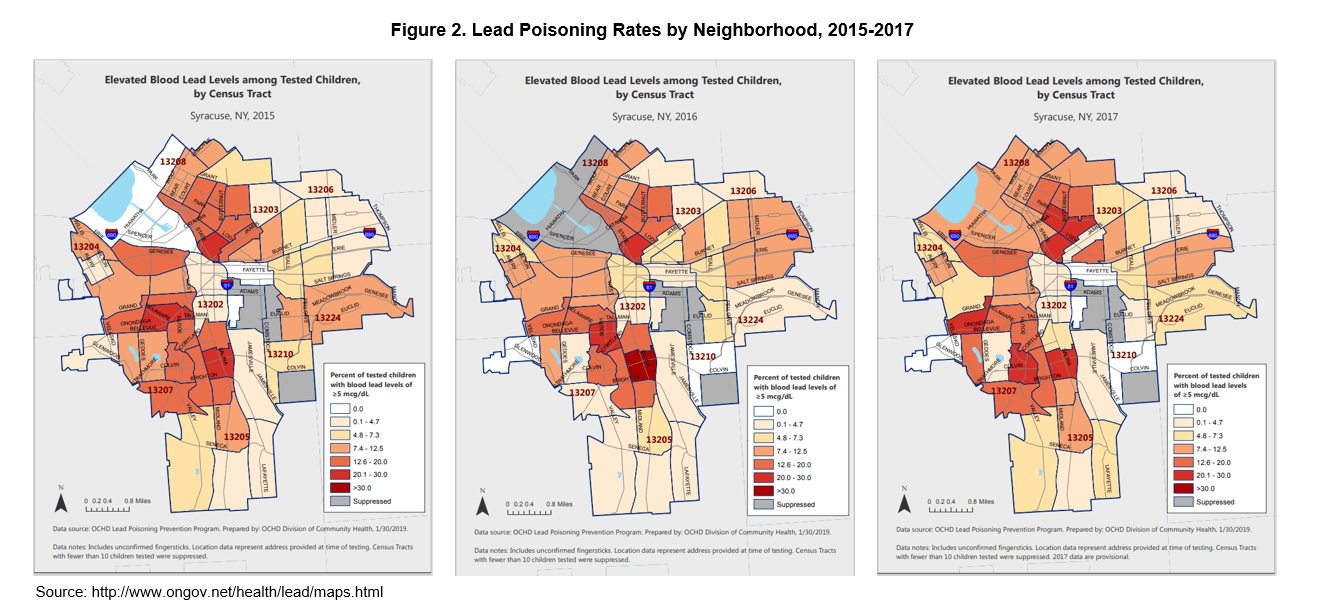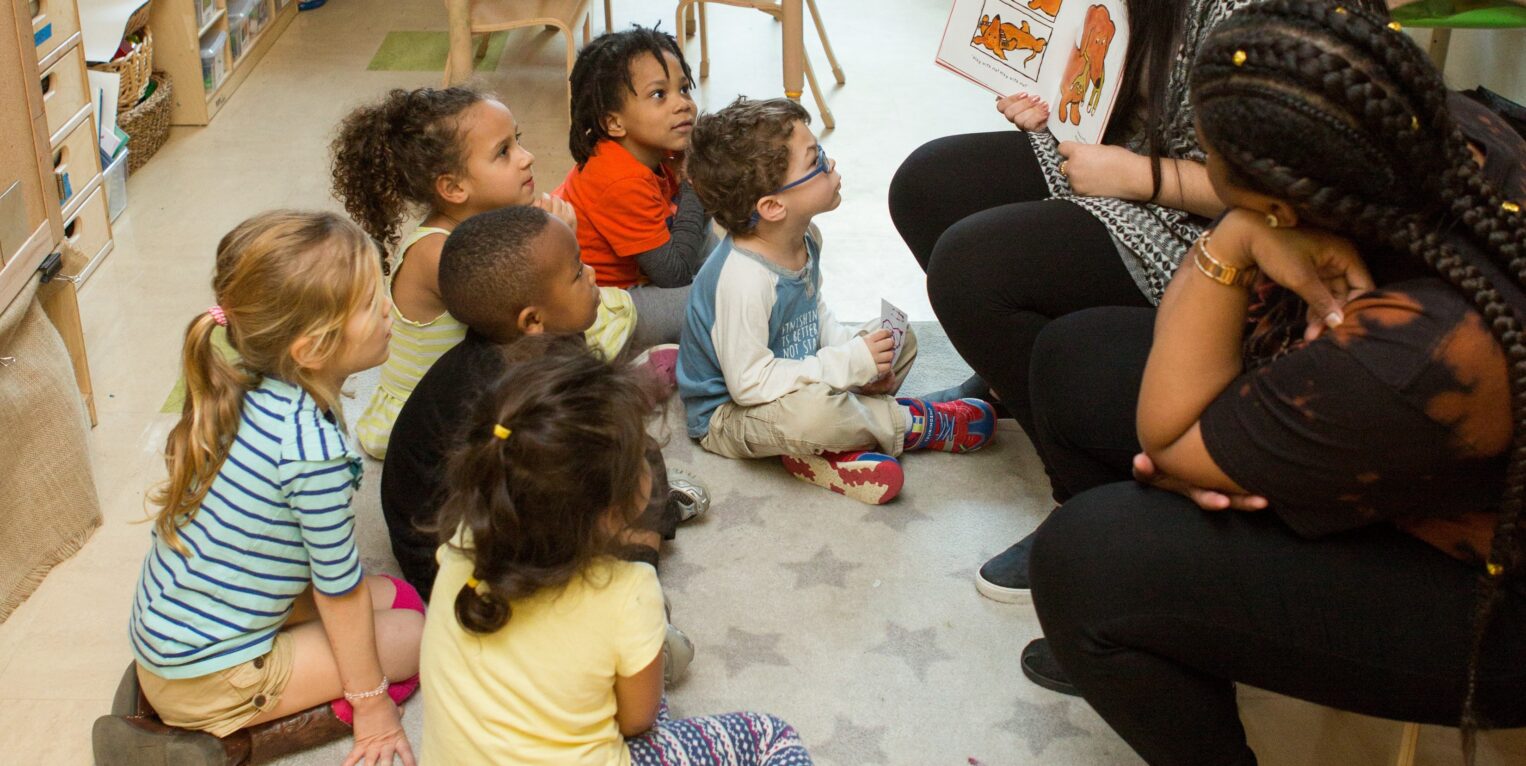The following paper examines the relationship between childhood lead exposure and third grade English Language Arts proficiency in Syracuse, NY. Our findings reveal a strong correlation between elevated blood lead levels in early childhood and low reading and writing scores later on. We present a new early warning system designed to identify and assist children in high-risk neighborhoods before exposure occurs, with the goal of improving long-term academic outcomes.
Written by Colby Cyrus, CAPM, Senior Program Manager and Frank Ridzi, Ph.D., Vice President, Community Investment
Download as PDFINTRODUCTION
Two and a half percent. That is the percentage of one-year-olds in Onondaga County who tested positive for lead poisoning in 2024. That is also the percentage of lead poisoning cases that could have been prevented with an early warning system designed to intervene when children are in the extremely vulnerable 0-12 month age range. Even more alarmingly, less than 20% of students in the Syracuse City School District (SCSD) have tested proficient in reading and writing by grade three in the past decade. This lags not only behind New York State – where average proficiency rates fall at around 45% – but also behind other local school districts.
As Figure 1 shows, SCSD trails its suburban counterparts by a dramatic margin, in some cases by 50% or more. What is causing this disparity? We conducted this analysis to determine if one contributing factor might be coming from the floors, walls, and windows in the child’s home. Lead poisoning puts Syracuse on the national map for all the wrong reasons. Nearly 10% of children in Syracuse have elevated levels of lead in their blood, a staggering rate eclipsing the national average of 2.5% by almost 400% (Hauptman et al., 2017). Deteriorating paint is largely to blame, found in a majority of Syracuse’s older homes that were built before the national ban on lead-based paint took effect in 1978. However, recent attention has also been paid to lead in water pipes.
The consequences of lead on a child’s health range from problems with reading and learning to permanent brain damage (American Academy of Child & Adolescent Psychiatry), leading us to consider the extent of its impact on reading and writing in third grade when students first take standardized ELA (English Language Arts) tests. Our analysis shows that there is a strong correlation between the two, allowing us to lay the groundwork for an early warning system. Neighborhoods with the highest lead levels ought to be the neighborhoods in which targeted outreach takes place to test for lead poisoning at a very early age. Our community’s early warning system allows us to flag when a child moves into, or within, a known high-lead area, prompting a chain reaction connecting the family with optional lead testing and additional follow-up. In the long term, this system is designed to result in improved ELA proficiency rates by the time the child reaches third grade.

Examining the Connection between Lead Exposure and Test Scores in our Neighborhoods
While previous research has found links between high blood lead levels and 3rd grade ELA scores on a county level (Strayhorn and Strayhorn, 2010), our research is the first to conduct this analysis on a neighborhood level. To understand this relationship, we first identified the neighborhoods with the highest rates of lead poisoning in the 2015-2017 timeframe, in order to use this as a reference point for ELA scores later on. Doctors in New York State are required to test children for lead at the ages of one and two, meaning a child testing positive for high lead in 2015 would be in third grade roughly six years later, in 2021. Using the lead poisoning maps that Onondaga County provides, we were able to discern that neighborhoods on the south side and the near north side frequently exhibit the highest lead levels. In some instances, over 20% of children suffer from elevated levels of lead in the blood, as seen below:

Having a baseline of lead poisoning rates in neighborhoods across the city, we obtained ELA proficiency metrics from the city’s Open Data Portal for the 2021-2023 time frame, seeking to quantify the percentage of third graders in these neighborhoods that were below levels of proficiency in ELA. With both sets of data, we were able to test the degree to which lead poisoning rates in a neighborhood are correlated with substandard ELA proficiency in those same neighborhoods around six years later. This relationship turned out to be significant – that is, as lead poisoning increases in a neighborhood, the percentage of third graders testing below proficient in ELA also increases.

Using Lead to Build an Early Warning System
Knowing that this relationship exists, we developed an early warning system intended to flag children living in the highest lead neighborhoods. This system is a collaborative effort among different community partners, each of whom is involved at a different stage in the process (see Figure 4). When a child is born and enrolled into the Dolly Parton Imagination Library (DPIL), their address will be flagged if they live in a known high-lead neighborhood. From there, the Literacy Coalition of Onondaga County (which runs DPIL) can ask the family if they want to be reffered to the LeadSafeCNY Coalition, who will connect them with testing and resources about lead poisoning. As a result, the system will allow these children to be set up with lead testing as early in the child’s life as possible, to prevent exposure and forestall any lasting effects. To track progress, all of the metrics that the LeadSafeCNY coalition gathers will flow into a centralized reporting dashboard, allowing us to see in real time how many referrals have been made, which neighborhoods are the most common, and how many tests have been conducted. Even when a child tests positive at the age of one or two, the effects have already taken hold and the damage is irreversible. This makes early action crucial, and the early warning system permits intervention to take place before the child encounters lead.

CONCLUSION
The early warning system builds on our ongoing investments to address both lead poisoning and childhood literacy. Such efforts have focused on replacement of windows and doors, education of residents and landlords, and construction or renovation of rental units with respect to lead. In the realm of literacy, we have fostered a variety of local programming and established a system through the Literacy Coalition of Onondaga County to distribute over 16,000 books to children each month. While the Central New York Community Foundation has so far invested nearly $3,000,000 to help put an end to childhood lead poisoning, the early warning system will play a role by helping to address the problem further upstream: that is, allowing an intervention to take place before a child is poisoned.
Even with a new lead ordinance in place and rigorous efforts to make homes safer, we cannot make each home healthier right away. The cost of doing so would be prohibitive. In the meantime, we can be strategic – we can ensure that any home with children, particularly those in high lead neighborhoods, are prioritized for intervention. Lead poisoning is a strain on our public health system and a toxin for our youth – but is one to which we can respond.
The intention of the early warning system is to be proactive, to forestall lead poisoning’s effects on children before the results are irreversible. Our previous work through the LeadSafeCNY coalition has been done with the goal of addressing the sources of lead in the home. However, we must also consider the longer-term impacts on children. Our kids need to be proficient in ELA by third grade. ELA proficiency is critical for success throughout the rest of the child’s school career, including college, and eventually in the workplace. Without sufficient ELA skills, a child’s upward mobility potential will be strongly inhibited. For that reason, addressing lead poisoning is not just a health issue – it is an economic one.
References
- American Academy of Child and Adolescent Psychiatry. (2023, October). Lead exposure in children affects brain and behavior (Facts for Families No. 45). https://www.aacap.org/AACAP/Families_and_Youth/Facts_for_Families/FFF-Guide/Lead-Exposure-In-Children-Affects-Brain-And-Behavior-045.aspx
- Hauptman M, Bruccoleri R, Woolf AD. An Update on Childhood Lead Poisoning. Clin Pediatr Emerg Med. 2017 Sep;18(3):181-192.
- Mapping Childhood Lead Poisoning in Syracuse. Onondaga County. Available at http://www.ongov.net/health/lead/maps.html
- New York State Education Department. (2024, August 20). State Education Department releases preliminary data on English Language Arts, Mathematics and Science state exams. New York State Education Department. https://www.nysed.gov/news/2024/state-education-department-releases-preliminary-data-english-language-arts-mathematics-and-science-exams
- Our Impact. LeadSafeCNY. Available at https://www.leadsafecny.org/our-impact.html
- Strayhorn JC, Strayhorn JM Jr. Lead exposure and the 2010 achievement test scores of children in New York counties. Child Adolescent Psychiatry Mental Health. 2012 Jan 23;6(1):4. https://www.osc.state.ny.us/files/state-agencies/contracts/2021/pdf/prompt-contracting-report-2021.pdf








